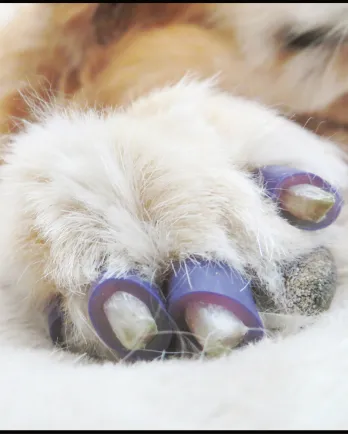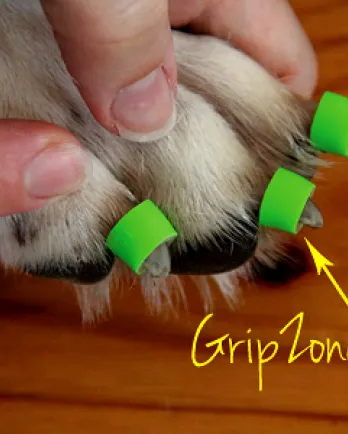Improving Canine Mobility: An Interview with Dr. Julie Buzby, DVM
Dr. Julie Buzby, a member of Grey Muzzle's Advisory Board, is an integrative veterinarian. She has also developed ToeGrips, devices that improve mobility in dogs by providing them with better traction. In this interview, we asked Dr. Buzby about her veterinary work, how she came to develop ToeGrips, and how these devices help dogs with mobility problems.
What is integrative veterinary medicine and how did this come to be your approach to treating animals?
Integrative veterinary medicine combines a conventional Western medical approach with complementary alternative modalities for a comprehensive health care paradigm.
I graduated from veterinary school in 1997 as an enthusiastic young veterinarian and quickly learned I wanted to do more for my patients than offer pills and/or surgery. As a student, I worked for horse vets who performed animal chiropractic and acupuncture and witnessed firsthand how dramatically the horses responded. I sought to add these tools to my toolbox, completing certification through the American Veterinary Chiropractic Association in 1998 and the International Veterinary Acupuncture Society in 2002. Taking advantage of the full spectrum of techniques available to me, I use integrative medicine as the only approach for treating my patients.
What are some of the common reasons why older dogs suffer from mobility problems? What therapies help?
The obvious answers are orthopedic disease (such as arthritis), neurologic disease, injury, and cancer, but I’ll share with you my “off the beaten path” thoughts.
One of the main reasons senior dogs suffer from mobility problems is that their toenails are not maintained. Long toenails (especially chronically, over a lifetime) negatively alter posture and gait, and also set up for injury. Combine that with poor conformation (from bad breeding) and you’ve got a recipe for disaster. It’s only a matter of time until the musculoskeletal system starts to break down.
Another contributing factor is that many dogs are overweight. Obesity is an epidemic in our pets and seniors have less of an ability to compensate for carrying the extra weight, which increases the force on the joints and also increases inflammation in the body. One landmark study proved that obesity increased both the incidence and the severity of arthritis in dogs.
I firmly believe that pain and mobility issues have to be treated with a multimodal approach, which means that we use many different techniques and products to achieve synergy.
Appropriate therapies may include:
-Joint supplements
-Adequan injections
-NSAIDs
-Omega 3 fatty acids
-Pain medications
-Herbs
-Hot and cold therapy
-Massage
-Therapeutic LASER treatment
-Spinal manipulation/Animal chiropractic
-Acupuncture
-Physical rehabilitation therapies (a growing invaluable branch of veterinary medicine)
-Electrical stimulation (TENS, NMES)
-Extracorporeal Shock Wave Therapy
-Therapeutic ultrasound
What are ToeGrips and which dogs will benefit from using them?
Have you ever seen a dog slip, slide, or struggle to rise on a hard-surface floor?
ToeGrips are the unique traction solution designed for those senior and special needs dogs. ToeGrips are natural rubber rings that fit onto their toenails to enable traction on floors and stairs.
ToeGrips have been successfully used on:
-arthritic dogs
-dogs with hind end weakness
-dogs with cruciate ligament injury
-blind dogs
-dogs with certain neurologic conditions
-tripawd dogs
-dogs rehabilitating from an injury
-therapy dogs who have a fear of slick floors
How did you come to develop and market ToeGrips?
By virtue of the type of medicine I now practice, most of my patients are grey-muzzled. I felt equipped to help their pain and mobility, but was perpetually frustrated by my lack of a reasonable solution for their slipping. My recommendation was throw rugs, which worked well if the dogs stayed exclusively on their carpeted path through the house. But inevitably the dogs would choose to go lie on cold, hard floors and have to get up from those floors. I needed a solution that stayed on the dog and not the floor.
One day I saw it, and my hair stood on end. One of my clever clients came up with the idea of using rubber devices on his dog’s nails. He wasn’t interested in pursuing his idea, but I thought it had the potential to revolutionize the lives of older dogs who lived on hard floors. Once I started using them on my patients, I was amazed by how well they worked. They did even more than I expected. My patients regained traction and confidence, instantly. With my client's blessing, I applied for a patent, did intense product research, and brought to market Dr. Buzby's ToeGrips for Dogs.
Do you have a favorite story of a senior dog that benefited from ToeGrips?
One of my favorites has to be Gus, a 15-year-old Scottie who had such poor mobility that he had to be carried up the 13 steps to my front door the first time I met him.
I had never seen him walk before, since he was carried into my kitchen, but after applying ToeGrips, we set him down to walk on my hardwood floor. Not only did he walk, he even trotted, and his human companion became teary-eyed. He explained that Gus hadn’t exhibited that level of mobility and confidence in many months.
Gus went on to thrive over the next year, even running up the steps to my front door when he came for his ToeGrips. No other variables had changed, but the traction that Gus gained through ToeGrips allowed him to rebuild muscle and stamina. Quality of life drastically changed for Gus and his human family. That is a hallmark of the testimonials we receive—the dogs are happier and their people are ecstatic. I’m blessed to be a peripheral part of that transformation!
How do ToeGrips work to keep a dog stable? What are the advantages of ToeGrips over other non-slip devices such as booties?
A dog's natural mechanism for traction is to flex the paws and engage the nails (like soccer cleats digging into the earth), but hard nails cannot gain purchase on a hard floor. ToeGrips simply grip the floor in a way that a dog’s toenails cannot, enabling traction the natural way.
I do believe that booties and boots have a place in veterinary medicine, but they’ve never been my go-to traction solution, even before I had ToeGrips. They are unnatural for dogs. They cover sensitive tissue (including the paw pads through which dogs sweat) and interfere with a dog’s gait and proprioception.
ToeGrips work naturally, are brilliantly simple, and miraculously effective!
What is the most common concern or question that people have before using ToeGrips and what do you tell them?
A consistent misconception by people who’ve never used our product is that dogs won’t tolerate ToeGrips on their nails.
In fact, very few dogs (around 2-3%) bother with their ToeGrips. The explanation is logical. Since the grips rest only on the nail and not sensitive tissue like skin or paw pads, they aren’t really even noticed by the typical dog.
That’s a message I appreciate having the opportunity to share, because I hate to see people write off the product without understanding why ToeGrips are a very practical and natural solution.
I never set out to own a pet product business, but we exist because of dogs like Gus. I knew that I HAD to make ToeGrips available to other dogs, beyond my patients. ToeGrips aren’t the right solution for every dog’s mobility issues (and for that reason we offer a money back guarantee), but for many dogs, ToeGrips can be truly life-changing.
For more information about ToeGrips, visit www.toegrips.com.
The information presented by The Grey Muzzle Organization is for informational purposes only. Readers are urged to consult with a licensed veterinarian for issues relating to their pet's health or well-being or prior to implementing any treatment.
You can find out more about Dr. Julie Buzby and all of Grey Muzzle's Advisory Board members here. The Grey Muzzle Organization improves the lives of at-risk senior dogs by providing funding and resources to animal shelters, rescue organizations, sanctuaries, and other nonprofit groups nationwide.
Interviewed by KE Magoon, Grey Matters Blog Manager and Editor





